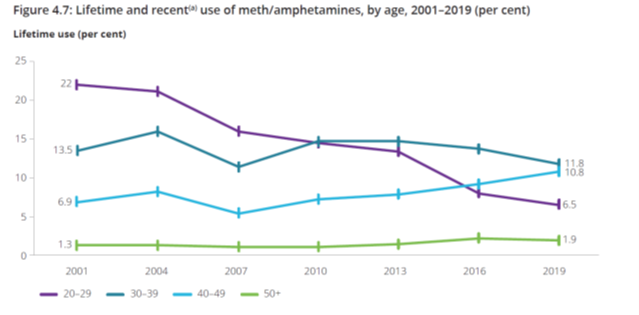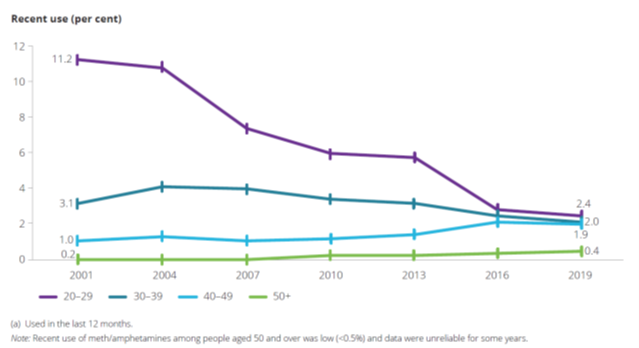Meth/Amphetamines

Crystal/ice still the main form of meth/amphetamine used
Meth/amphetamine comes in many forms including powder/pills (speed), crystal methamphetamine (crystal meth or ice) and a sticky paste (base). Crystal/ice is usually the purest form, followed by base then speed. The ‘high’ experienced from ice and base is much more intense, and with intense reactions come powerful responses including comedown, the potential for dependence (addiction) and chronic physical and mental health problems.
In 2013, there was a change in the main form of meth/amphetamine used, with crystal/ice replacing powder as the preferred form. In 2019, this trend continued, with 50% of people who used meth/amphetamine reporting that crystal/ice was the main form used in the previous 12 months. This has remained stable since 2013 but increased from 22% in 2010. Over the same period, use of powder decreased from 51% in 2010 to 29% in 2013 and to 20% in 2019.
Form of meth/amphetamine used affects frequency of use
People who used crystal/ice as their main form of meth/amphetamine were far more likely to use it monthly or more often than people who used mainly powder/speed—47% compared with 15.4%—a similar trend reported since 2010. Daily and weekly use among people who reported using mainly crystal/ice has doubled since 2010, from 12.4% to 29% in 2019.
How many people who use meth/amphetamines may be at risk of problem drug use?
Several questions from the ASSIST-Lite were added to the 2019 NDSHS questionnaire to better understand what proportion of the population may be at risk of problem drug use and in need of intervention (see Box 2.1 in alcohol chapter/Technical notes for more information about the ASSIST-Lite).
Among people who had used meth/amphetamines in the last 12 months:
- 7.5% were at high risk of harm and could be dependent or experiencing severe problems and in need of referral for specialist assessment and treatment
- 56% were at moderate risk of developing problems related to their substance use and should be offered brief intervention by a health professional
- 36% were categorised as low risk
Meth/amphetamine use declining among younger people
Meth/amphetamine use has been declining since it peaked at 3.4% in 2001 and stabilised in 2019 (1.4% in 2016 and 1.3% in 2019). While no statistically significant changes by age or sex were detected between 2016 and 2019, use has been declining among younger age groups since 2001 but increasing or remaining stable among older age groups (40 and over) (Figure 4.7).
In 2001, people in their 20s were 11 times as likely to use meth/amphetamines in the previous 12 months as people in their 40s (11.2% compared with 1.0%) but meth/amphetamines no longer appears to be the drug of choice among this demographic. In 2019, people in their 20s were only 1.3 times as likely to use it as people in their 40s (2.4% compared with 1.9%).

(Page 40).

(Page 40).
Reference: Australian Institute of Health and Welfare 2020. National Drug Strategy Household Survey 2019. Drug Statistics series no. 32. PHE 270. Canberra AIHW. Pages 39 – 40.

